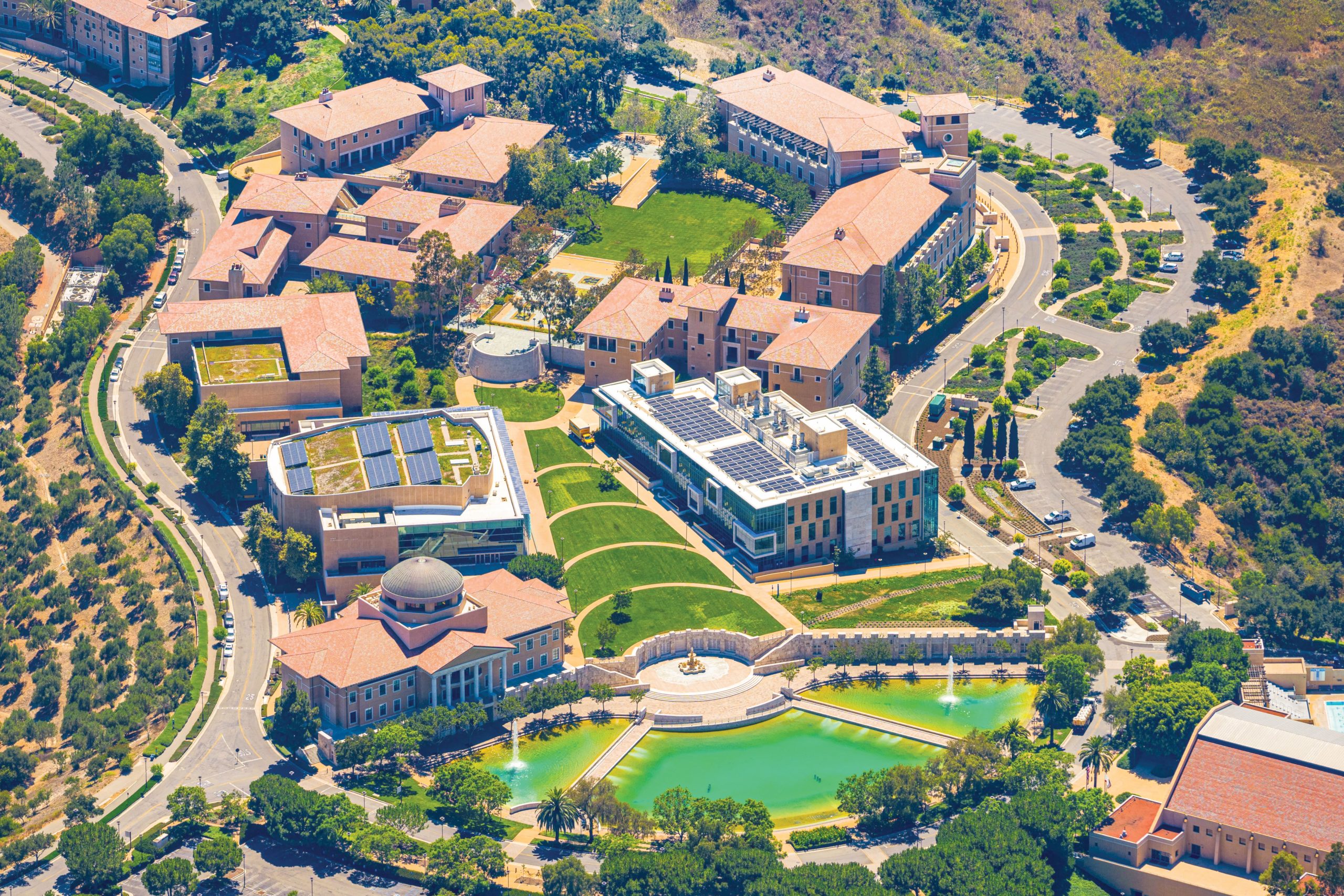In July 2001, The New York Times reported on “an architectural and educational marvel reach[ing] skyward above the Pacific, waiting to spring to life.”[1]
A month later, Soka University of America, the first liberal arts college to be built in California in two decades, welcomed its first class of 120 students from 18 countries and 18 U.S. states.
The significance of the nonsectarian four-year liberal arts undergraduate school, founded by Daisaku Ikeda dedicated to Soka education, was perhaps best crystallized in a note that physicist and Nobel Peace Prize laureate Joseph Rotblat wrote to the founder: “Your dream has come true.”[2]
The need for a university grounded in the Buddhist principles of peace, human rights and the sanctity of life was tragically underscored a month after classes began, when the Sept. 11 terrorist attacks killed nearly 3,000 people in New York, Pennsylvania and Virginia.
In a message immediately following the attacks, Ikeda Sensei wrote that humankind would never see the light of peace as long as one party sought to subjugate the other by force, “both sides caught in a vicious cycle of reprisals”:
The importance of dialogue cannot be overstated. Nothing must be allowed to impinge upon its free exchange. For unless we put an end to an era dictated by sheer force of arms, the 21st century will be no different from the 20th, and we will regress once more into a century of war.[3]
The second series of Seven Bells had just begun,[4] and in a headquarters leaders meeting held that same month and attended by 41 SGI-USA youth representatives in Tokyo, Sensei called for fostering “global citizens, people who are more than merely Japanese, or American or any other nationality. We must extend the network of global citizens who possess both a positive philosophy and true capability, and who are dedicated to joining hands with all people on this planet and advancing with them.”[5]
Beatrice Lopez was among the 41 youth who were returning home from the SGI youth training course when their plane was diverted to Canada on the day of the Sept. 11 attacks.
When Ms. Lopez returned to New York, her leadership team united to ignite the spirit of shakubuku as the means to transform the land. Led by youth, they introduced some 200 people to Nichiren Buddhism that year.
The new century became a time when the youth began focusing on sharing Buddhism based on a vow, marking the first expansion campaigns led by a new generation of youth.
“For me, I learned that true happiness can be created in times of despair,” Ms. Lopez said. “It was the time when I learned to absorb and put Sensei’s guidance into action; I learned not to waste time. I decided this is the way I will live my life, with Sensei, based on the oneness of mentor and disciple.”
The Curtain Rises on the Second Act of Global Kosen-rufu
The efforts to expand the SGI-USA with youth in the vanguard were bolstered in June 2007, when the SGI-USA created a three-territory organization—East, Central and West—to empower each part of the country to grow and stand on its own, a change that Sensei said signaled the “opening of the second act of global kosen-rufu” and whose victory lay in the shared struggle of mentor and disciple, and the unity of many in body, one in mind:[6]
The time has arrived for new and substantial progress in American kosen-rufu. You have stood up with the Mystic Law for a peaceful world, for the happiness of the people, and for the security of your family and loved ones. Because of this, your mission is profoundly important. Please take care to ensure the accomplishment of kosen-rufu in America, which is essential for the entire world.[7]
The members’ efforts across decades to create trust in their communities culminated the following year with the opening of the SGI-USA Washington, D.C., Culture Center on Embassy Row. At the June 25, 2008, opening, SGI Vice President Hiromasa Ikeda assured the members that their prayers would penetrate the surrounding embassies, and the new center would serve as an “SGI Embassy” for members around the world.
“Now Is Your Time to Take the Lead”
In June 2010, just a month after Sensei celebrated the 50th anniversary of his inauguration as third Soka Gakkai president, he chose not to attend the headquarters leaders meeting, explaining thus:
During the assembly where Shakyamuni preached the Lotus Sutra, his disciples repeatedly pledged to him that they would carry out the widespread propagation of the Law just as he had taught, asking him to put his mind at complete ease on that account.
True victory in this cause can only be achieved when the disciples are serious in their commitment, united in purpose, and pray and take action without begrudging their lives.
This is the spirit of disciples who inherit the heart of the Lotus Sutra.[8]
A month later, the SGI-USA held the “Rock the Era”–themed Youth Culture Festivals, with more than 30,000 youth gathering in Chicago, Long Beach, Calif., Philadelphia, Hawaii and Guam for modern-day entrustment ceremonies in which they joyfully assumed the mission and responsibility to accomplish kosen-rufu alongside their mentor. The era of youth leading the kosen-rufu movement in the U.S. had truly begun.
‘Once You Decide What Is Fundamental, Nothing That Happens Will Sway You’
This new era took on a deeper dimension at the start of 2013, when the youth, adopting the word challenge as their motto for the year, pledged to introduce 3,000 new capable youth to the SGI-USA based on a vow, with the full support of all members—their Soka family.
Shortly afterward, the first North America Youth Leaders Study Conference was held at the Florida Nature and Culture Center in Weston, Florida, where, on Jan. 26, 2013, the participants received news that Sensei had named the new youth advanced study program for the U.S. the “Ikeda Wisdom Academy.”
In a message to the conference, Sensei emphasized the mission his youthful successors would play in the coming decades:
Nichiren Daishonin wrote to the young Nanjo Tokimitsu, “My wish is that all my disciples make a great vow.”[9] This one statement constitutes the Daishonin’s eternal guideline for all youth throughout the 10,000 years of the Latter Day of the Law.
As youth, you face all sorts of difficulties, and wrestle each day with worries and problems. Precisely for this reason, it is crucial that you stand up with a great vow and strive to achieve a fundamental goal. Once you decide what is fundamental, nothing that happens will sway you, and you can grow by leaps and bounds.[10]
In 2013, Lenny Bogdonoff had just moved to New York from China to finish his last semester of college. He worked full time and attended school on the weekends, a period he recalled as the hardest in his life.
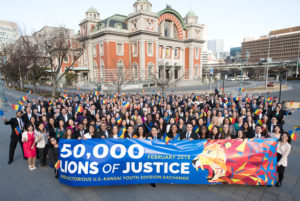
Mr. Bogdonoff had never helped someone begin their own Buddhist practice, but it was during this campaign that he began doing shakubuku and introduced several people to the practice.
That year, he was hired at his first software development job despite having no formal experience in the field, a move that opened up a promising career with top global media and technology companies. “I have a real appreciation for having found a solid personal philosophy at a crucial moment in my life,” he said. “Because I understand how much it impacted me, I think that to share Buddhism with another person and inspire hope in them is the best thing I can do in return.”
By early November 2013, the youth not only surpassed their propagation goal but also enabled 3,000 youth to take the Introductory Exam the next month, setting a natural rhythm of propagation and study in the U.S. that has been expanded since.
Maya Gunaseharan had just graduated from college and moved to a new city for work when she joined the Ikeda Wisdom Academy. As she studied Sensei’s philosophy of Soka humanism, she realized that, as a Bodhisattva of the Earth, she had vowed to take on her circumstances, experiences and sufferings so that she could encourage everyone around her.
Today, Ms. Gunaseharan works in the field of education, focusing on diversity, equitability and inclusivity. Last month, she gave birth to her first child, Myles Potoff. When she came home from the hospital, Ms. Gunaseharan said she was overcome with emotion because everything she has achieved is the result of fighting to respond to her mentor.
“At this time, the only way to transform our country and the world is to spread Sensei’s philosophy of Soka humanism far and wide,” she said. “That’s the way I know to repay my debt of gratitude to Sensei—by winning in my daily life and fighting to share Buddhism so we can actualize his vision of peace.”
The year 2013 concluded with the opening of the Hall of the Great Vow for Kosen-rufu in Tokyo. It is the place where members the world over come together, in rich diversity, to chant Nam-myoho-renge-kyo and refresh their own great vow for kosen-rufu, sharing the same heartbeat as the three eternal mentors, Tsunesaburo Makiguchi, Josei Toda and Daisaku Ikeda. Sensei shares:
The heart of the great vow for kosen-rufu and the life state of Buddhahood are one and the same. Therefore, when we dedicate our lives to this vow, we can bring forth the supreme nobility, strength and greatness of our lives. When we remain true to this vow, the limitless courage, wisdom and compassion of the Buddha flow forth from within us. When we wholeheartedly strive to realize this vow, the “poison” of even the most difficult challenge can be transformed into “medicine,” and karma transformed into mission.[11]
The changes that took place at the start of the decade have since been expanded and developed. On the eve of the 55th anniversary of worldwide kosen-rufu, Sensei gave the American organization “Four Mottoes for the New Departure of American Kosen-rufu:”[12] 1. America of Courage; 2. America of Capable People; 3. America of Unity; and 4. Be the Model for Worldwide Kosen-rufu!
On Sept. 23, 2018, SGI-USA youth gathered in nine U.S. cities for the peace festival “50,000 Lions of Justice: Ushering in an Era of Hope and Respect.” It was the modern-day March 16 entrustment ceremony in which the youth of America, with a great roar, vowed to stand in solidarity with the world’s people and act as the protagonists for a new era of peace.
Sensei has emphasized America’s role as the model for worldwide kosen-rufu:
I love America. I am convinced that the positive qualities Americans stand for—cheerfulness, freedom, kindness, studiousness, good humor and hard work—are ideals embraced by global citizens and are consistent with the humanism we in the SGI strive to cultivate.
The SGI-USA’s progress serves as a model for and gives hope to the entire world. The greater the development of the SGI-USA, the greater the momentum will be for the progress and expansion of worldwide kosen-rufu.[13]
As the SGI-USA celebrates the 60th anniversary of Sensei’s first visit to the U.S. and the starting point of global kosen-rufu, the members are focusing on studying The New Human Revolution as the eternal roadmap for kosen-rufu. Quite naturally, they are also sharing Buddhism with others, having dialogue that illuminates our shared humanity and fostering the youth as the means to create a country that Sensei has long envisioned—one that treasures the dignity of life, one that knows peace.
Click here to read: Afterword to The New Human Revolution
Becoming a Capable Person for Kosen-rufu
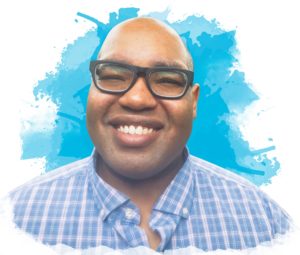 Jimmy Anicet
Jimmy Anicet
Boston
Before I started practicing Buddhism in 2012, I would stay in bed for months, feeling like I wasn’t a capable human being. But then I met so many amazing people in the SGI who encouraged me to muster a fighting spirit to make the impossible possible.
In 2013, the 3,000 youth shakubuku campaign toward the completion of the Hall of the Great Vow for Kosen-rufu was a turning point for me. In his message commemorating the opening, Ikeda Sensei says: “The heart of the great vow for kosen-rufu and the life state of Buddhahood are one and the same. … When we wholeheartedly strive to realize this vow, the ‘poison’ of even the most difficult challenge can be transformed into ‘medicine,’ and karma transformed into mission” (Nov. 29, 2013, World Tribune, p. 3).
I realized that, if I fought for kosen-rufu with everything I had, I would definitely experience Buddhahood. In this process, a lot of deep-seated negativity came out of my life. But each time, I went back to Sensei’s guidance, chanted Nam-myoho-renge-kyo and never gave in to devilish functions.
Then, in September 2019, my brother took his own life. With my mom in tears as the police came to our home, I seriously chanted not to be swayed. I felt that Sensei had trained me to face this crucial moment head-on. My trust in Sensei’s words became stronger than my own disbelief. And as I prayed for my brother’s happiness, I felt that he would want me to be happy, too. In a sense, he urged me to push my life forward.
I decided to wholeheartedly support the happiness of others as the newly appointed North Zone young men’s leader and to finally pursue my dream in computer programming—something I never thought possible. I’m now preparing for a career in software engineering while doubling down on my passion as a stand-up comedian.
Understanding the preciousness of life, I don’t hesitate to share Buddhism with others and have helped many friends join the SGI. Just as Sensei taught me, I want others to know that even the most difficult challenges can be transformed into great mission.
Developing a Love for Humankind
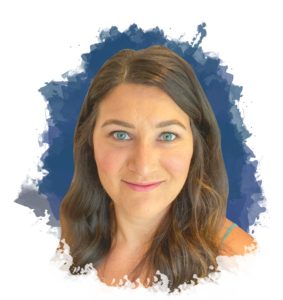 Karla Meier
Karla Meier
Chicago
As a teenager, I worked at a bagel shop but had no ambitions besides smoking weed. I remember thinking one day while high on a shift, I could do this for the rest of my life. That thought terrified me, and I reconsidered how I valued my life and future.
I decided I wanted to live a meaningful life and dove into my Buddhist practice. I studied briefly at a college in Minnesota, but it didn’t feel right, and was encouraged to apply to Soka University of America, which Ikeda Sensei founded in 2001. SUA’s approach to education—one that “fosters love for humankind, that develops character”[14]—touched my heart. I was accepted in the spring of 2004.
In my sophomore year, the university enabled a group of students to start an alternative spring break program in which we traveled to New Orleans to help clean out mold-infested houses after Hurricane Katrina. We had a little over two days to raze a house’s interior and, though we were sincere, we were not an ideal labor force. It was so daunting and hot that we thought we might fail. But on the last day, we united with Sensei’s spirit to never give up and felt a strong sense of responsibility to set the precedent for future SUA students. We went from being super lethargic to determined, even joyful, and we finished! That night, I realized it was March 16, Kosen-rufu Day. For me, this served as a clear example of the power of the oneness of mentor and disciple.
This was one of many opportunities I had at SUA that pushed me to awaken to a sense of my greater self. All of my SUA experiences prepared me for my current job as a senior director of marketing and public relations at a higher education consulting organization.
The university’s mission is not theoretical. It’s real work—we get in the trenches, put dialogue to the test and, together, face global issues and the deep-rooted karma of the U.S. I’m eternally grateful for having attended the school that my mentor founded. It was the best education I could have received.
I’m determined to reflect SUA’s value of leading a contributive life in my work and in society, while staying connected to the SUA community and supporting its continued growth.
Pursuing My Dreams
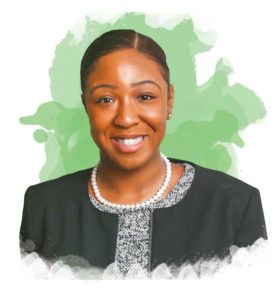 Jasmin Johnson
Jasmin Johnson
Long Beach, Calif.
I used to cry several times a week about my appearance and personality as a 13-year-old. This was when I started practicing Buddhism consistently. From that point on, people would tell me that I seemed brighter and happier, although it took me a while to believe them.
In high school, I pushed myself academically and even tutored other students, but many of my college applications were rejected. Through my disappointment, I chanted Nam-myoho-renge-kyo and, little by little, I started to realize that I was worth more than my looks, grades or school.
I ended up studying accounting on a full scholarship at Fisk University, a prestigious, historically Black university in Nashville, Tennessee. I decided to pursue a career in financial investment to bring Buddhist humanism into the world of finance and help shift the field to valuing human beings. This is my dream and way of advancing kosen-rufu.
Going into my senior year, I was interning at an investment bank. I had a difficult experience there and didn’t receive a full-time offer. I was crushed, but instead of quitting, I decided to challenge how I felt. I had to chant a lot to realize that it wasn’t about my ego or what others thought—it was internal. Can I win over myself? This would be my true victory.
Because of Ikeda Sensei’s encouragement and example, I had the confidence to not give up in that crucial moment.
Through newfound opportunities, I received my master’s at Vanderbilt University, and this past summer, I was accepted into Harvard University’s MBA program. Before starting there, I get to gain professional experience in the field and take risks with my career.
When we cherish human life first, the way we fundamentally operate changes. This is something I want to build a career on as an investor, and I’m starting to make this dream a reality.
References
- July 25, 2001, The New York Times, p. 1. ↩︎
- Daisaku Ikeda, For the Leaders of the 21st Century: Founder’s Memorable Remarks (Aliso Viejo, California: Soka University of America, 2005), p. 117. ↩︎
- Sept. 28, 2001, World Tribune, p. 1. ↩︎
- It refers to the seven consecutive seven- year periods in the Soka Gakkai’s development from May 3, 2001, and continuing through 2050. ↩︎
- Oct. 12, 2001, World Tribune, p. 7. ↩︎
- July 6, 2007, World Tribune, Special Pullout, p. A. ↩︎
- Ibid. ↩︎
- June 25, 2010, World Tribune, p. 8. ↩︎
- “The Dragon Gate,” The Writings of Nichiren Daishonin, vol. 1, p. 1003. ↩︎
- Feb. 15, 2013, World Tribune, p. 2. ↩︎
- Nov. 29, 2013, World Tribune, p. 3. ↩︎
- Oct. 2, 2015, World Tribune, p. 4. ↩︎
- Ibid, p. 2. ↩︎
- www.soka.edu/about/proud-heritage ↩︎
You are reading {{ meterCount }} of {{ meterMax }} free premium articles

